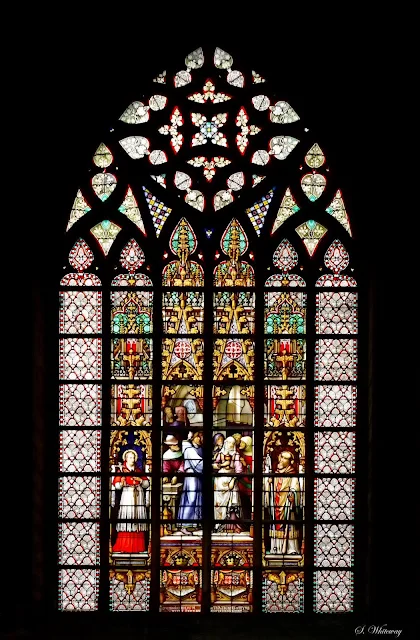 |
St. Michael's and St. Gudula
Cathedral |
My husband and I walked around Brussels without a destination or plan during our visit in 2011. We came upon St. Michael and St. Gudula Cathedral and on whim, decided to go inside. I can honestly say this was one of our better decisions. The stained glass windows are some of the most beautiful I have had the pleasure of viewing. The rest of the Cathedral is also exquisite but I admit to focusing on the windows.
The church's construction began in the 11th century and was largely complete by the 16th, though its interior has undergone frequent modifications over time. The choir was constructed between 1226 and 1276 with the façade completed in the mid-fifteenth century. The two front towers were completed in the early 16th century under Charles V. The Cathedral of St. Michael and St. Gudula is the national church of Belgium and was granted cathedral status in 1962. It is the finest surviving example of Brabantine Gothic architecture. The cathedral is built of stone from the Gobertange quarry.
 |
The last Judgment (1528)
|
Stained glass was primarily a religious art form and with the spread of christianity (and other religions) resulted in the growth and proliferation of this art form. Perhaps the most outstanding feature of the interior of St. Michael and St. Gudula Cathedral are the stained glass windows, created by a variety of stained glass masters from the 16 to 19 centuries.
The oldest window in the cathedral depicting is the Last Judgement, that was installed in 1528. The artist responsible for this beautiful work is actually unknow, though some people think it was the work of Frans Floris but others are not so sure. This beautiful Renaissance stained-glass window depicts the prince-bishop of Liège and was donated in 1528 by him (Erard de la Marck (1472-1538)) as a tribute to the emperor Charles V.
Jan Haeck from Antwerp is credited with producing both of the cathedral’s transept windows in 1537 after drawings by Bernard van Orley. Some of the other 16th century windows in the church were produced by Nicolas Rombouts, a master glass-painter to the Court of Margaret of Austria. Jean De Labaer of Antwerp executed 4 windows from designs by himself and those of Theodor van Thulden in the 1650s. Many of the remaining windows were produced by JB Capronnier between 1848 and 1880. Such a diverse group of artisans from several centuries has resulted in a variety of styles which rather than distracting lends to the charm of St. Michael and St. Gudula Cathedral.
The photographs of the stained glass are processed to highlight the stained glass rather than the architecture. I believe that the beauty of stained glass is how the pieces and colours fit together to create a visual framework with light adding the mood and directing the piece's story.
Jean Haeck Stained Glass
The stained glass windows were made by Jan Haeck are based on drawings by Bernard van Orley (ca 1488-1541). Haeck and van Orley were also responsible for the windows adorning the northern and southern transepts (ca 1537-1548).
 |
| 1537 |
 |
| 1538 |
 |
| 1547 |
Jan De LaBaer Stained Glass
The stained glass windows created by Jan de LaBaer (ca 1603-1668) were executed per his design (1) or from designs (3) of Theodoor van Thulden (1606-1690). The stained glass windows by de LaBaer consisted of four windows in the Lady Chapel (constructed 1645-1659) of St. Michael and St. Gudula Cathedral, executed between 1654-1663.
 |
| Jan de Labaer per own design 1654 |
 |
| 1663 |
 |
| 1658 |
Jean-Baptiste Capronnier Stained Glass
Jean-Baptiste Capronnier (1814–1891) was a Belgian stained-glass painter born in Brussels. Many credit him with the modern revival of glass-painting. An interesting footnote is that he was also an entomologist specialising in Lepidoptera and a member of the Royal Belgian Entomological Society.
 |
| 1870 |
Stain Glass from the Chapel of St Mary Magdalene
A baroque chapel dedicated to St. Mary Magdalen (or Maes chapel, after the family who funded it in 1675) and was once used as the burial crypt for the Maes family). It is baroque-style and hexagonal in shape. It is surmounted by a small cupola with stained glass by JB Capronnier.
Unknown
The attribute of the following stained glass pieces is unknown or rather I was unable to find information regarding the artist(s) responsible for their execution. The differing styles suggest 3 different artists were responsible for them.
 |
| 1843 (Capronnier ?) |
The following websites provide additional information on stained glass and the Cathedral of St. Michael and St. Gudula
https://stainedglass.org/resources/history-of-stained-glass/
http://www.cathedralestmichel.be/
















































